The rise in popularity of soft blacks and saturated dark hues is a direct response to our current uncertain times, and they’re likely to become even more relevant in post-pandemic times as we recuperate from this long period of stress.
These richer, darker hues can feel luxurious, brimming with moody, timeworn comfort. This colour trend goes hand in hand with the increased focus on creating stress-free environments that combine elements of natural materials, gentle colours and extreme comfort combined with an underlying sense of escapism – like a reclusive retreat to a faraway destination. The ideology perfectly marries with the notion of ‘cocooning’, a colour and decorating concept that revolves around the idea of creating a safe, comforting interior, removing you from the angst and uncertainty of the outside world.

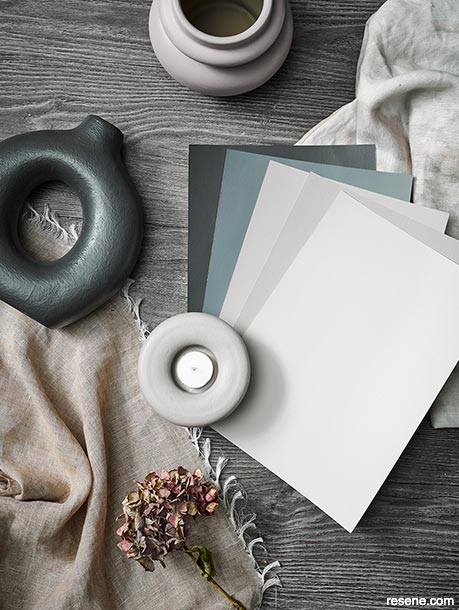


A cocooning ambiance is synonymous with softness and calm. The look is about truly embracing darker shades, not just bringing pops of it into a lightly coloured space with furniture or creating a feature wall but going all-in with an inky shade to create a room that envelopes you.
Start by choosing a deep and timeless tone that speaks to you. In this space, we opted for walls in Resene Nocturnal – a soothing, night-time off-black – as the base colour for our scheme in this chic and elegant living space. The wall colour is supported with timber flooring stained in deep Resene Colorwood Crowshead, which allows the beauty and texture of the wood’s natural grain to show through without deviating from the all-encompassing strategy of our cocooning colour scheme.
From here, creating a serene, relaxed space can be achieved by starting with the fundamentals: considered, comfortable furniture, a pared back tonal accent colour scheme and a few nods to nature. A backdrop built with soft blacks makes way for the introduction of a secondary accent hue that’s added through layered accessories like painted vases, plant pots, bowls and candleholders as well as coordinating textiles strewn across the sofa. Calming shades offer a less confused and cluttered aesthetic that achieves a more serene and interesting space. Incorporating these through a variety of materials adds character to a space in a gradual way.
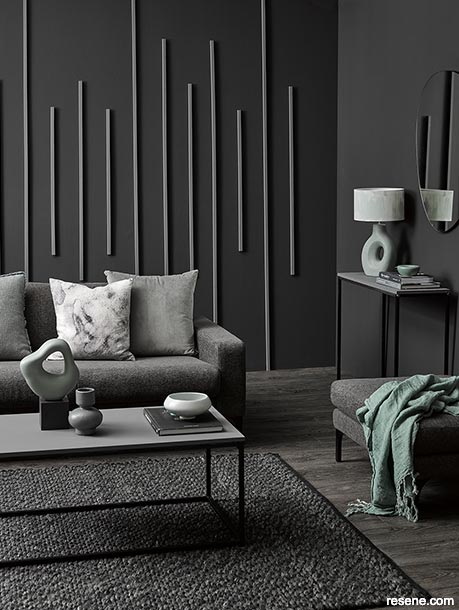
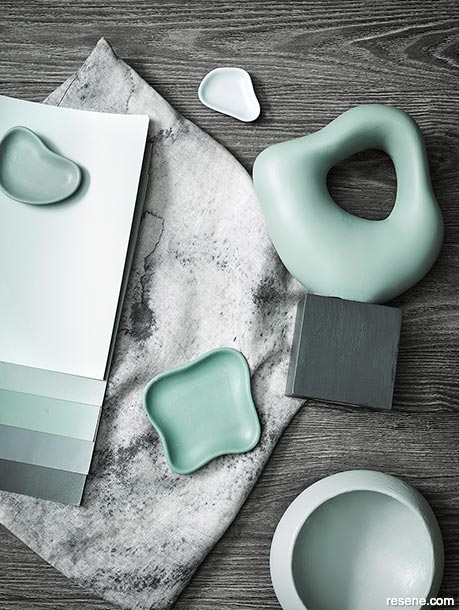


The beauty of a scheme based in soft blacks is that it opens the door for a wide range of accent colours that will complement it well, so the choice comes down to which colour family you find restful and appealing. One option is an array of minky mauves, such as Resene Martini, Resene Tom Tom and Resene High Tea. Another could be glassy blue greens like Resene Nebula, Resene Tiara, Resene Yucca and Resene Blue Smoke. Whichever hue you’re leaning towards, remember to opt for dusty, understated, pastoral versions to keep the accent colour from creating too strong a reaction. And be sure to layer in a variety of similar yet slightly different tones to create interest and avoid your accessories looking too ‘matchy matchy’.
Darker wall colours also form a much better background for paintings and artworks than white – something art galleries and museums have more recently discovered. However, finding a piece of artwork that’s large enough to define your living space can not only be difficult and intimidating, but it’s also often costly. With an interesting batten design, your wall becomes the artwork. We painted our battens in slightly lighter Resene Half Tuna so that the effect would stand out more from the wall. We also carried this hue on to the tops of our console and coffee table to bring the colour further out into the room, creating a harmonious effect.

Once you paint your room a saturated hue, remember that it may take time to accustom yourself to the new look. Leave it for a week until you adjust to the dramatic transformation, and you’re bound to fall in love with the effect.
If you are still hesitant, start your cocooning transformation in a cloakroom or small bedroom, as richer colours work very well in small spaces – despite the common misconception that only white and light paint colours are suitable. In fact, darker colours are better at receding and can make the space feel larger yet up the cosiness factor.
Accessories pink version: Sofa and ottoman in from King Living; Mirror from Freedom; Pink cushion cover from H&M Home; Kate spade pattern cushion, Blush linen throw from Allium; Rug and books are stylist’s own.
Accessories green version: Sofa and ottoman from King Living; Mirror from Freedom; Malmo throw and cushion from Adairs; Weave verson juniper cushion from Allium (this is one that has squares and triangles on it in the green colour way); Lamp from Kmart; Pale grey broadway velvet cushion from Freedom; Grey watercolour cushion from Penney and Bennett; Vila Fringe cushion from Nood.
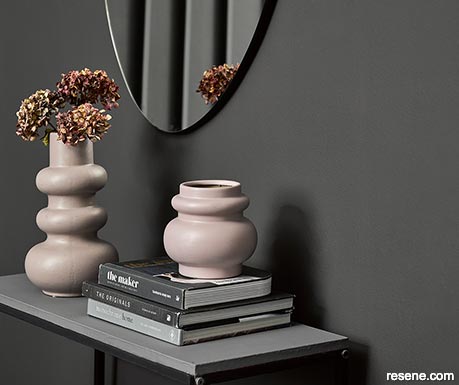

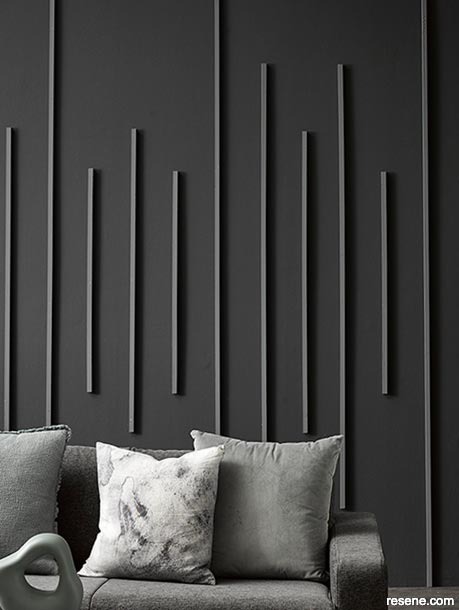
Paint your main wall colour in two coats of Resene SpaceCote Low Sheen. While your wall is drying, use a mini roller or paint brush to paint your battens in the same colour as your wall, if you want them to blend in. Or choose a secondary colour to make them stand out. We painted our wall in Resene Nocturnal and our battens in lighter Resene Half Tuna.
Drill narrow holes near the ends of each batten to make hanging easier and to avoid cracking the wood when you go to attach them to the wall.
Measure and mark the centre of each of your battens lightly with a pencil.
Find the vertical centre of your wall using measuring tape and a level and lightly draw a horizontal line across your wall. Mark and measure the horizontal length of where you would like your battens to be placed on your wall then divide this distance by 18. Subtract the width of your batten from this number and the resulting measurement will be the distance of the gaps you will leave between your battens.
Plan out your design by laying your battens out on the floor in front of your wall in the order you wish to hang them. To get a similar look to our wall, alternate shorter and longer lengths of batten. Use your pencil to lightly number the back of each batten then move them aside.
Hang your first batten by aligning the centre mark with your horizontal wall line. Use a level to make sure your placement is square, then attach the batten to the wall using countersunk screws or nails through your predrilled holes.
Measure your pre-determined gap distance from the side of your attached batten to determine where the opposite side of your subsequent batten will fall. Align the centre mark of your next batten to both the horizontal wall line and your gap measurement and attach it to the wall. Continue until all battens have been hung.
Fill holes with Resene EzyFill. Once dry, sand filled areas smooth using fine sandpaper or sanding block then wipe away any dust with a clean, dry rag. Use a small paintbrush to repaint over these areas in two coats with your batten colour.
Erase any visible pencil marks with a white rubber eraser. Or touch these spots up using leftover paint.
Styling by Vanessa Nouwens. Photography by Wendy Fenwick. 2022
Colour inspiration - latest looks gallery
Get inspired with colour and the latest decorating and colour trends! Select just the right look and mood for your space.
Filter: kids & teens | greens | blues | yellows | neutrals | oranges/browns | pinks/reds | greys/blacks | violets | pops-of-colour/multi-colour
Bring the hamptons home
Hamptons coastal lounges in neutral or blue tones
Freshly squeezed living
These lush greens are a fitting match for zesty citrus